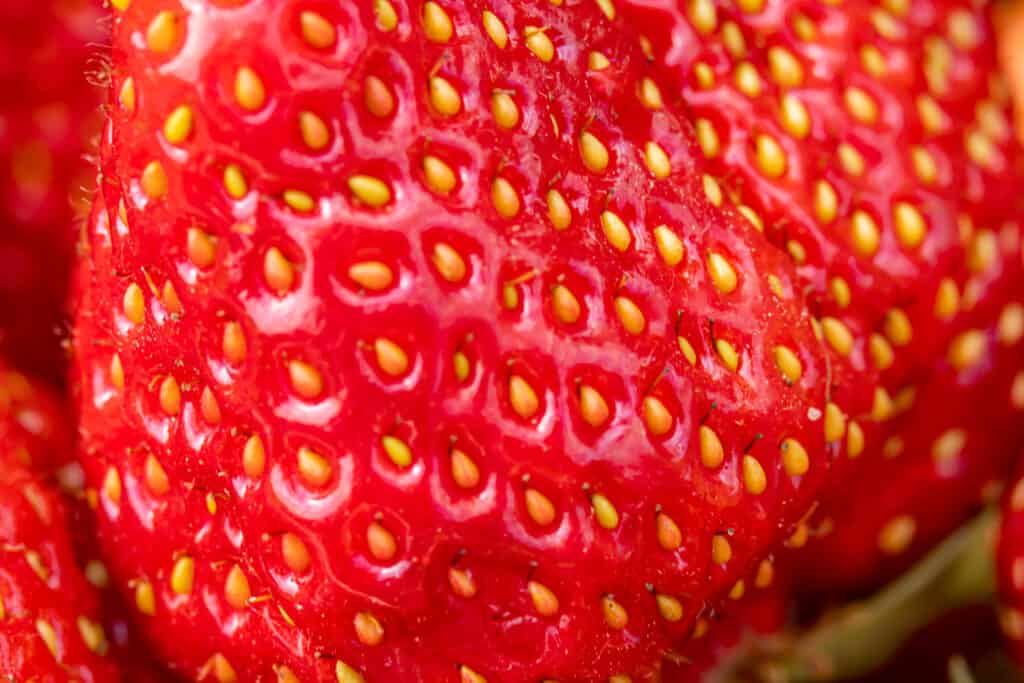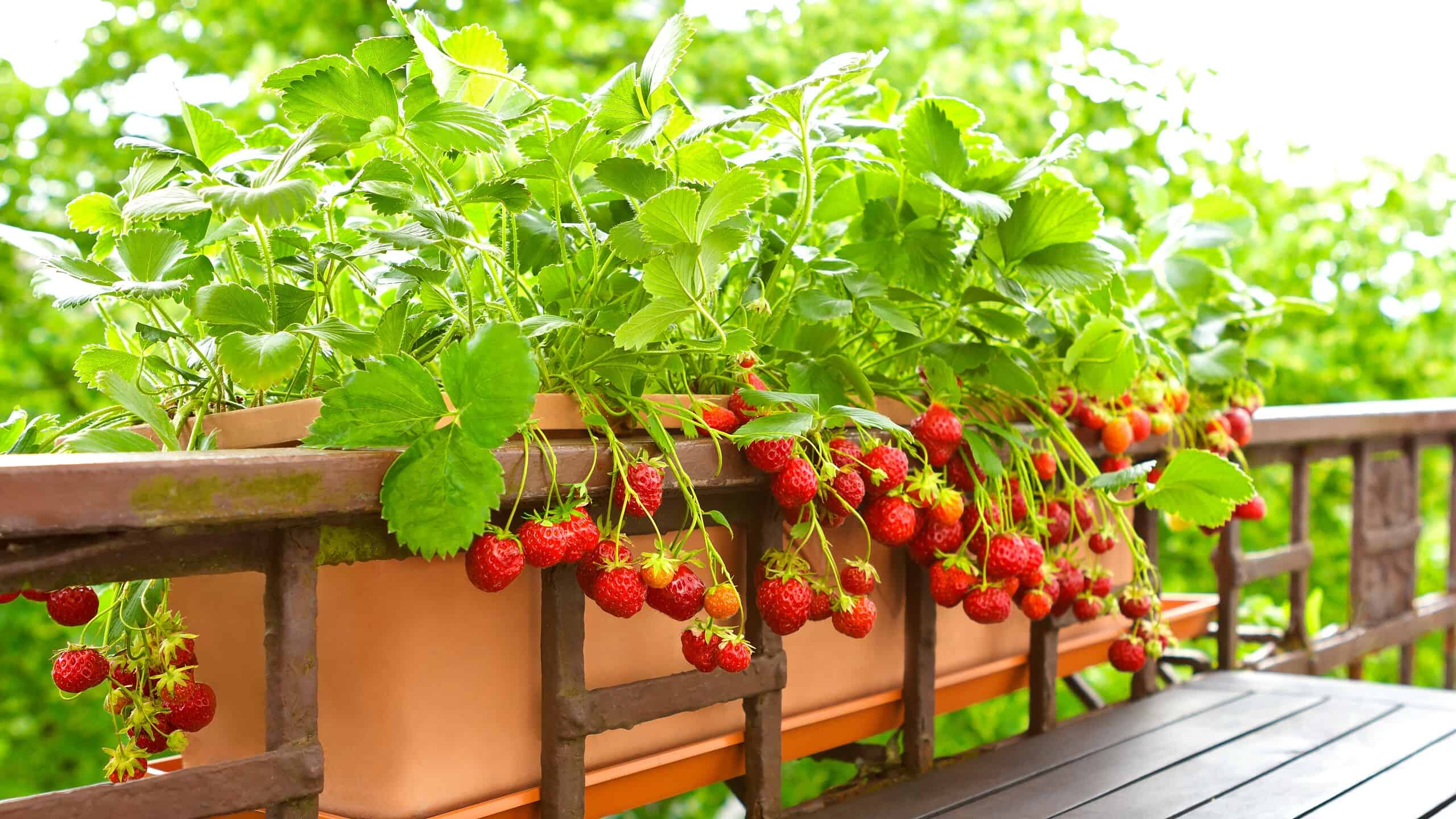Roll up your sleeves and prepare for an adventurous dive into California’s lusciously red world of strawberries! California, with its sunny skies and fertile soil, claims bragging rights as a powerhouse in the strawberry-growing world. This tiny, heart-shaped wonder isn’t just a sweet treat; it’s a testament to California’s agricultural prowess. California is the largest producer of strawberries in the U.S.!
Strawberry season unfurls its magic from spring to early summer, painting the Golden State’s fields with vibrant hues of red and a refreshing aroma. But before you get lost in this delicious berry fantasy, let’s not forget that growing these juicy gems requires a bit of know-how, a generous sprinkle of patience, and a dash of love.
Whether you’re a seasoned farmer or a green-thumbed beginner, this article is your guide to mastering the art of strawberry cultivation. In this guide, we’ll explore the nuances of California’s strawberry season and share valuable tips for nurturing your bountiful berry harvest.
When Should Strawberries Be Planted in California?
When it comes to growing strawberries in California, timing is crucial for achieving optimal yields and healthy plants. The state’s diverse climate and geographical variations present different planting schedules for various regions. Understanding the right time to plant strawberries ensures that farmers and gardeners make the most of California’s abundant sunshine and favorable growing conditions.
When to Start Strawberries in Coastal Regions
In the coastal areas of California, where the climate tends to be milder and more moderate, the best time to plant strawberries is typically in the early spring. Coastal regions benefit from the ocean’s cooling influence, which helps maintain stable temperatures throughout the year. It is advisable to start planting in March or early April, once the risk of frost has passed and the soil has warmed up. Planting during this period allows the strawberry plants to establish their root systems before the onset of the summer heat.
When to Start Strawberries in Inland Valleys
Moving inland to California’s fertile valleys, the ideal planting window for strawberries differs slightly from the coastal regions. The inland valleys experience hotter summers and cooler winters compared to the coast. Here, it is recommended to plant strawberries in late winter or early spring. February and March are generally considered the best months for planting in these areas. By starting early, growers can take advantage of the cooler temperatures and ample rainfall during the late winter months, giving the plants a head start before the scorching summer arrives.
When to Start Strawberries in Mountainous Regions
The mountainous regions of California present a unique set of challenges for strawberry cultivation due to their higher elevation and cooler temperatures. In these areas, it is essential to adapt the planting schedule accordingly. As the growing season is shorter, it is best to delay planting until late spring or early summer, once the threat of frost has passed. By waiting for the warmer weather, strawberry plants have a better chance of thriving and producing a bountiful harvest.
When to Start Strawberries in Desert Regions
California’s desert regions, such as the Coachella Valley, require specific considerations for successful strawberry cultivation. The hot and arid climate poses challenges for growing this delicate fruit. To overcome these obstacles, it is advisable to plant strawberries during the cooler months of the year. In these areas, planting typically takes place in the fall, around October or November. By taking advantage of the milder temperatures, growers can establish strong plants before the scorching summer heat sets in.
When Should Strawberries Be Harvested in California?
As it is with starting or planting strawberries, timing is crucial when it comes to harvesting them to ensure peak ripeness and taste. The Golden State’s diverse climate and geographical variations create different harvesting windows across various regions.
When to Harvest Strawberries in Coastal Regions
The coastal regions of California boast a moderate climate that is favorable for strawberry production. Here, strawberries are typically ready for harvest in the late spring and early summer months. The precise timing may vary depending on the specific microclimate and strawberry variety being grown. The cool ocean breezes and mild temperatures along the coast contribute to slow and steady fruit ripening, resulting in strawberries with excellent flavor and quality.
When to Harvest Strawberries in Inland Valleys
Moving inland to California’s fertile valleys, the harvesting timeline for strawberries can be slightly different. In these regions, where temperatures tend to be hotter, strawberries are typically ready for harvest in late spring and early summer, similar to the coastal areas. However, the warmer temperatures in the inland valleys can accelerate fruit ripening, requiring growers to monitor their fields closely. Harvesting strawberries at the optimal time ensures that they reach their full sweetness and juiciness.
When to Harvest Strawberries in Mountainous Regions
The mountainous regions of California present unique challenges and variations in harvesting strawberries. Due to the higher elevation and cooler temperatures, strawberries in these areas mature at a slightly slower pace compared to the coastal and inland regions. Consequently, the harvesting window for mountainous areas falls later in the summer, extending into early fall. Patience is key in these regions, as waiting for the strawberries to fully ripen results in a more satisfying harvest.
When to Harvest Strawberries in Desert Regions
In California’s desert regions, such as the Coachella Valley, the extreme heat poses specific considerations for strawberry harvesting. The scorching temperatures experienced in these areas can expedite the ripening process and affect the quality of the fruit. As a result, growers in the desert regions often opt for early morning or late evening harvests when temperatures are cooler. By carefully timing the harvest, they can preserve the strawberries’ taste and prevent overripening or damage caused by the intense heat.
How to Know if a Strawberry is Ripe
To determine if a strawberry is ripe, carefully examine its appearance, texture, and aroma. Look for vibrant red coloration across the entire fruit, avoiding green or white patches. Gently touch the strawberry; it should feel firm yet yield slightly to pressure. Check for a sweet, fragrant aroma, as this indicates ripeness. Just as well, inspect the strawberry’s green cap; if it appears fresh and intact, it suggests optimal ripeness. By considering these visual, tactile, and olfactory cues, you can confidently identify ripe strawberries ready to be enjoyed, ensuring a delightful and flavorful experience.

Strawberries are usually ready to be picked if they are deep red and are just slightly squishy when gently squeezed.
©iStock.com/Oleg Prolat
Where is the Best Place to Plant Strawberries in California?
California provides diverse landscapes and climate conditions, making it an excellent state for planting strawberries. However, identifying optimal locations within the state is crucial for successful strawberry cultivation.
Coastal regions in California offer favorable conditions for growing strawberries. Areas like Santa Cruz, Monterey, and Ventura County have gained recognition for their thriving strawberry fields. The coastal breeze and moderate temperatures contribute to a longer growing season, resulting in flavorful strawberries. Sandy soils prevalent in these areas aid in proper drainage and prevent root-related issues.
The fertile inland valleys, including the Central Valley and Salinas Valley, serve as ideal planting sites for strawberries. These regions benefit from ample sunlight and nutrient-rich soils, promoting healthy plant growth and high yields. Cities like Fresno, Bakersfield, and Stockton have established successful strawberry production in the inland valleys. The warm summers and mild winters create a favorable climate for strawberries, ensuring sweetness and juiciness in the fruit.
While not commonly associated with strawberry cultivation, certain mountainous areas in California present unique opportunities for planting. The Sierra Nevada foothills and selected regions in San Diego County offer microclimates that support strawberry growth. Elevated terrain in these areas results in cooler temperatures, providing relief from the intense summer heat. Although the growing season may be shorter, strawberries cultivated in mountainous regions can possess exceptional flavor.
What Varieties of Strawberries Grow Best in California?
As mentioned earlier, California’s favorable climate and diverse growing conditions make it an excellent region for cultivating strawberries. Choosing the right strawberry varieties is crucial for successful cultivation in the state.
June-Bearing Strawberry Varieties
June-bearing strawberries are popular among California growers due to their high yields and exceptional flavor. These varieties produce a concentrated harvest during late spring to early summer. Some top-performing June-bearing varieties in California include Chandler, known for its large, juicy berries and excellent flavor; Camarosa favored for its firm berries with classic strawberry taste and good shelf life; and Albion, offering sweet and aromatic berries with good disease resistance.
Day-Neutral Strawberry Varieties
Day-neutral strawberries are well-suited for California as they produce fruit continuously throughout the growing season, unaffected by day length. These varieties allow for an extended harvest period. Seascape is highly regarded for its exceptional flavor and high yields, making it a great choice for California’s coastal regions. Tribute offers a balance of flavor, productivity, and adaptability to various California regions, while Evie-2 performs well across the state, producing medium-sized, flavorful berries with good disease resistance.
Ever-Bearing Strawberry Varieties
Ever-bearing strawberries provide the advantage of multiple harvests during the growing season. They offer flexibility and a continuous supply of strawberries. Quinault, known for its sweet taste and delicate aroma, thrives in California’s coastal regions. Fort Laramie, a cold-hardy variety, adapts well to different climates in California and produces medium-sized, firm berries. Ozark Beauty combines exceptional flavor with excellent disease resistance, making it suitable for various regions across the state.
Tips and Tricks for Growing Strawberries in California
Growing strawberries at home in California can be a rewarding and delicious experience. To ensure successful cultivation, it is important to follow some key tips and tricks. Let’s take a look at some recommendations for growing strawberries in California’s diverse climate and unique growing conditions.
Choose the Right Planting Site
Selecting the right site for your strawberry patch is crucial for successful growth. Choose a location that receives full sun for at least six to eight hours a day. Ensure the area has good air circulation and well-draining soil to prevent waterlogging and root rot.

If you want to plant your strawberries in a container, doing so is possible, but the lifespan of the plant will be longer when planted directly in-ground.
©Quality Stock Arts/Shutterstock.com
Opt for the Best Possible Variety for Your Climate
When choosing strawberry varieties for your home garden, consider factors such as taste preference, disease resistance, and adaptability to California’s climate. Some recommended varieties for California include Chandler, Seascape, and Albion, which are known for their flavor, productivity, and adaptability.
Prep Your Soil
Prepare the soil before planting strawberries. Amend it with organic matter, such as compost or well-rotted manure, to improve drainage and fertility. Aim for a slightly acidic soil pH between 5.5 and 6.5, which is optimal for strawberry growth.
Plant Your Strawberries Properly
Plant strawberry crowns or bare-root plants in early spring, once the threat of frost has passed. Dig a hole large enough to accommodate the roots and crown, spreading the roots out and ensuring the crown is level with the soil surface. Space the plants about 12 to 18 inches apart to allow for proper air circulation.
Watering Requirements
Strawberries require consistent moisture, especially during fruit development. Water deeply but avoid overwatering, as this can lead to root rot. Aim to keep the soil evenly moist, but not waterlogged. Mulching around the plants can help retain soil moisture and suppress weeds.
Fertilization Requirements
Fertilize strawberry plants regularly to promote healthy growth and fruit production. Apply a balanced organic fertilizer, following the manufacturer’s instructions. Avoid over-fertilizing, as it can result in excessive foliage growth and reduced fruit quality.
Pest and Disease Management Tips
Monitor your strawberry plants regularly for signs of pests or diseases. Common pests include aphids, slugs, and snails. Use organic pest control methods, such as handpicking or using insecticidal soap, if necessary. To prevent fungal diseases, provide good air circulation and avoid wetting the leaves during watering.
Mulching Requirements
Apply a layer of good-quality organic mulch (we recommend damp wood chips) around the strawberry plants. Mulching helps keep weeds from growing, conserve moisture in your soil, and keep soil temperatures from getting too hot or too cold. It also prevents direct contact between the fruit and the soil, reducing the possibility of root rot.
Runner Management
Strawberry plants produce runners, which are long stems that develop new plantlets. Regularly monitor and trim the runners to prevent overcrowding and maintain plant vigor. You can propagate new plants by allowing select runners to root in separate pots, expanding your strawberry patch.
Harvesting Tips
Strawberries are typically ready to be picked when they are fully colored, dense, and have a sweet telltale strawberry aroma. Gently cut the ripe berries from the plants, being careful not to damage the surrounding fruit or plant. Harvest frequently to encourage continued fruit production.
Winter Care Tips
In colder regions of California, protect your strawberry plants during winter. Mulch around the plants with straw or leaves to insulate the crowns and prevent frost damage. Remove the mulch in early spring when the danger of frost has passed.
By following these tips and tricks, you can successfully grow strawberries at home in California. Select suitable varieties, prepare the soil, provide adequate water and nutrients, and manage pests and diseases effectively. With proper care, your homegrown strawberries will reward you with sweet and flavorful fruit, making your gardening experience in California even more enjoyable!
And if you find yourself not so interested in growing strawberries at home, you can find a ton of delicious, fresh strawberries at your local grocer or via U-pick farms during the peak season in late spring to early summer.
Thank you for reading! Have some feedback for us? Contact the AZ Animals editorial team.








